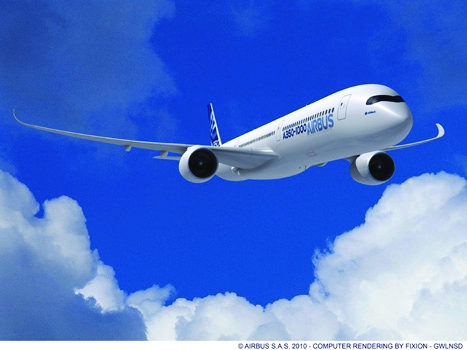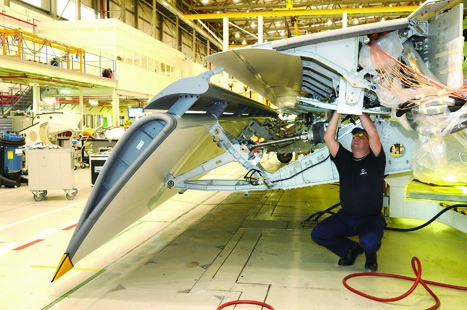If you can specify the development of human societies by the materials they use —stone age, bronze age, iron age and so on — then there’s a good argument for saying that we’re currently in the composite age. The lightness, strength and toughness of composite materials, bringing together the properties of a polymer matrix surrounding a reinforcing web of mineral fibres, and allowing a wide range of component shapes to be produced easily and quickly, has proved to be a godsend to engineers in many sectors, particularly aerospace.
But there’s a downside to every advantage. Most of the manufacturing sectors that use composites originally used metals, and composites behave very differently from metals. of particular interest to engineers, they break in different ways.

The journey to understanding how metal components fail in aerospace was painful - the catastrophic failure of the original design of the De Havilland Comet airliner in the 1950s showed how little was understood about metal fatigue. However, it is now well understood. But metals, with their crystalline structure and lattice atomic arrangement, are very different from composites, with their layers of oriented fibres, mass of relatively disordered polymeric chains, and the different types of atomic bonds in their various components. ‘There are many processes involved with composite failure at a micromechanical level, and they are all very complex; it’s difficult to understand them completely,’ explained Silvestre Pinho, a senior lecturer at London’s Imperial College, who is leading a project, co-funded by Airbus and Dassault Systèmes along with the EPSRC, to look at composite failure.
In a metal, the biggest danger is cracking, where a fracture can form and travel large distances through the material at high speed. ‘It’s to do with the plasticity. ductility and fatigue, but those are comparatively well understood,’ Pinho explained.
But even when you understand how a composite can fail, it doesn’t mean you can predict a component’s behaviour, because composite properties vary with size. ‘The strength and its variability decrease with scale, and toughness generally increases with scale,’ Pinho said.
There are a great many processes involved with composite failure at a micromechanical level and they are all complex
In many cases, composite failure prediction is done via computer simulation, particularly by using finite-element analysis (FEM); here, the motorsport industry has led the way. Using data gathered by testing the properties of small coupons of composite material, the whole structure is built up in the simulation in a way that’s almost analogous to the process of actually building the part: layer by layer, controlling the direction of the fibres in the composite and adding the properties of the polymer matrix between the layers. Different types of fibre can be added as necessary, until a complete virtual model of the component has been assembled.

This can then be twisted, compressed, stretched and subjected to every type of stress that the real components would experience, with a high degree of certainty that the system will model any failures or fractures that might occur.
There is nothing particularly wrong with this technique, Pinho says, and it ensures that the structures that are made are safe. ‘You don’t need to worry about flying in a composite aircraft, and if you want to predict the elastic response - how much the wing is going to deflect, for example - then that method is fine,’ he explained.
The problem is that because it’s so difficult to extrapolate the properties of a composite in a large structure from those of a testing coupon, engineers have to insert safety factors into their calculations, and this means that the properties of the composite are not fully exploited. ‘There are two things you can do: you can do more experimentation with your structure and optimise based on that, or you can rely on safety factors,’ Pinho said. The problem with the former is that it’s time consuming and expensive; although aerospace companies in the defence sector might have the resources for it, budgets are tighter in civil aviation and this may not be possible.
When you use safety factors to make up for a lack of knowledge, you cannot quantify how safe you are
Silvestre Pinho, Imperial College London
Safety factors mean that more material is being used than would be necessary if the failure modes were better understood, meaning that components are heavier and not necessarily better than a traditional metal component. ‘Also, we know that we’re playing too safe, but we can’t quantify how safe we are playing,’ Pinho said. ‘If you could understand the material completely, you might be able to say that a wing, for example, under given extreme loading conditions would break, say, 0.001 per cent of the time, and we’d be happy with that - we would be able to quantify the risk from first principles. We cannot do that completely at the moment. When you use safety factors to make up for lack of knowledge, you can’t quantify how safe you are, so you overdo it.’

Pinho’s project, Bridging the Scales, is looking at the micromechanical mechanisms of a failure mode called translaminar fracture. ‘It’s a particularly dangerous type of fracture, which breaks the whole thickness of a panel, such as whole wings and fuselages,’ he explained. ‘We are trying to understand how the fracture processes scale with size, so we’d still be able to use very small specimens for qualifying the material and verifying the properties, but we will be able to predict what would happen at a larger scale.’
Pinho’s team is planning on incorporating its results into software modules that would work with existing FEM suites, so that companies would be able to simply extend their current practices rather than using entirely new systems. The idea is that this would help reduce the need for experimentation and allow the strength, stiffness and lightness of composites to be more fully exploited. ‘At the moment, aircraft designers can’t realistically exploit composites to their maximum. We need to be able to do that if they are to be the best solution for an aircraft.’
indepth
Researchers are looking at how to build desired properties into a composite material
An alternative to predicting the properties of the composite with more accuracy is to build the desired properties into the material. Although likely to be expensive, this technique could allow extra functionality to be tailored into the composite.
One particularly interesting strand of research is looking at using the structure of the composite itself to monitor its condition. Being carried out at Queen Mary University of London, it is looking at using carbon nanotubes in the fibre part of the composite to form a damage-sensing network.
The research, led by polymer nanotechnology specialist Prof Ton Peijs, aims to use the electrical conductivity of nanotubes to detect the onset, nature and evolution of damagein a composite. This involves tailoring the structure of the composite to a high degree. Nanotubes would be incorporated into thermoplastic fibres, which would then be woven selectively into the fibres to form the reinforcing web for the composite. This, in turn, would be positioned in the composite component in areas where damage sensing is a particular danger.
Monitoring the conductivity of the section would then give operators information on the integrity of the composite; changes in conductivity in specific areas would pinpoint damage. Peijs’s team is hoping to combine this system with self-healing mechanisms to make components that would effectively be self-maintaining.




Collaboration to address viable solutions for VAWG database
<blockquote>address the lack of standardisation, coordination, and collaboration of gender disaggregated data intelligence across various regions,...